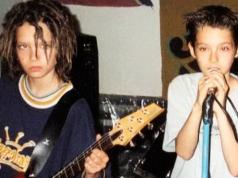Prairie dogs are relatives of the ground squirrel and groundhog. They owe their name to the yapping sounds they make. The black-tailed prairie dog (Cynomys ludovicianus) can be recognized by the black tip of its tail. These are golden-brown to reddish-brown animals with muscular legs and sharp claws, which are indispensable for digging spacious underground structures. Sociable animals maintain close social contacts. Together they build their homes, stock up for the winter, play or clean each other's fur.
LIVING TOGETHER IN CITIES
Prairie dogs live by the thousands in gigantic underground cities with an extensive network of dwellings. Inside the city, each family of prairie dogs, consisting of a male, one to four females, and young, lives in its own hole. When the young leave the nest, the females often remain in the neighborhood, while the males dig their own housing aside or occupy an abandoned apartment. How harmoniously families live, pregnant females and newly-made mothers behave just as aggressively. After mating, the fight for the best underground burrows begins among expectant mothers. 34-37 days after mating, each female gives birth to four to six cubs, which are born naked, blind and deaf. Many cubs are preyed upon by alien mothers, who keep rivals from rearing their young in order to improve the chances of survival for their own offspring. After the cub stops eating milk, the mother returns to her relatives.
VIGILANCE IS AN URGENT NEED
Black-tailed prairie dogs are a good food source for many carnivores. In order to protect themselves from them, prairie dogs guard the entrances to dwellings around the clock. Sitting on their hind legs and dangling their front legs, the “sentinels” watch the surroundings and, in case of danger, burst into sharp, annoying barking, which makes all relatives hide at home.
A BRIEF DESCRIPTION OF
Black-tailed prairie dog ( Cynomys ludovicianus)
Class Mammals.
Squad of rodents.
The squirrel family.
Distribution: North America.
Body length with head: 28-35 cm weight: 900-1400 g.
Diet: Predominantly herbs.
Sexual maturity: from 2-3 years.
Duration of pregnancy: 34-37 days.
Number of cubs: 4-6.
Life span: over 8 years (in captivity and reserves).

A close relative of the Western Asian hamster, unfortunately, can be very rarely found in Central Europe. Despite this, the common hamster ...



But he barks like a dog.
In wildlife, it was subjected to large-scale destruction, and now it is tamed as a pet. Way of life prairie dogs similar to the organization of the human community.
Features and habitat
The animals have chosen the desert-steppe western territories of North America, central Mexico. They are attracted by dry grassy plains with water bodies nearby, foothills. They do not like wet soils and lowlands.
Appearance Information prairie dogs in Siberia, Altai species turned out to be erroneous. Scientists identify five species of these rodents, each of which has chosen its own area for living, the color and style of the fur coat, and seasonal activities.

White-tailed, Mexican, Jutish dogs are known, black-tailed representatives are especially popular. In addition to them, Gunnison's dogs are distinguished. The inhabitants of the prairies were disliked by farmers for damage to the land and mass resettlement, affecting nature and increased food competition in the habitat.
The shepherds thought how to get rid of prairie dogs, exterminated rodents for the crippled and cattle that broke their legs in the holes of prairie dogs, located shallow from the surface of the earth.
Before the campaign to exterminate cute rodents, there were up to 100 million individuals. For the current period, less than 2% of the former population living in protected areas has survived. Adult representatives of prairie dogs grow up to 30-35 cm and 1-2 kg in weight, which varies depending on the season.

The females are slightly smaller than the males. The animals were nicknamed dogs for their characteristic sounds, similar to the barking of puppies.
Rodents are excellent diggers, strong paws with powerful claws are adapted for digging holes in dry ground. The color of the fur coat is from gray-brown to light beige on the abdomen. Large, wide-set eyes on a rounded head with ears hidden by thick fur. The tail is small and fluffy.
prairie dogs live in large colonies of several thousand individuals. In the underground labyrinth, there are many separate areas for the lifestyle of individual families. The laws of hierarchy and order operate in the society of smart and hardworking animals.
Burrows form complex tunnels, first in sloping corridors, and then in branches with many rooms for various purposes: pantries, nesting, shelter from predators or flooding, even separate toilets.

The length of such a labyrinth can be up to 350 meters in length and up to 5 meters in depth. On an area of 1 hectare inhabited by dogs, you can count more than 50 exits from the underground mansion.
An annular rampart of excavated earth is formed on the surface, which serves as a fence against flooding and a watchtower for possessions protected from enemies. defend yourself prairie dogs comes from foxes, snakes, from hawks attacking from above, falcons,.
The nature and lifestyle of prairie dogs
in the town prairie dogs has its own social structure. Each individual family consists of the head of a male, 3-4 females and two-year-old offspring, in total - up to 20 individuals.
The family is provided with separate housing, including "nurseries", where they give birth and feed babies. Defender males always guard their home and fight fiercely for it.

Strangers - neighbors are driven out patiently and persistently, avoiding physical struggle, only the most stubborn can be destroyed. The functions are strictly distributed in the community:
- builders - to create new galleries and repair old ones;
- security guards - in order to ensure the safety of the town;
- educators - to teach the new generation survival skills, etc.
Performance of work and the ability to communicate in their own language distinguishes prairie dogs as especially gifted social animals. The animals do not just bark and hit their tail at the same time, the ways of transmitting information are so diverse that scientists compare them with the dolphin language or with the level of communication of primates.
For example, prairie dog can convey by voice and posture not just a message about a threat, but to clarify who is approaching, from which side and how.

Therefore, when a hawk, a badger or a coyote approaches, the actions are different: they either take cover quickly, but stay at the exits, or go deeper, or only cautiously move closer to the mink.
The high activity of dogs is manifested during the day: they work, host in mink-houses, communicate friendly, help each other, play with kids. The sentry on its hind legs stands on an earthen rampart and surveys the surroundings.
The animals eat the grass above the town for a better view. Others clean their coats, build new toilets to replace the old ones, babysit the neighborhood's growing children while mommy is busy with the younger generation. Among the closest in the family there is a ritual of "kiss", contact with open mouths. Relatives here are trusting and caring.

The black-tailed prairie dog does not hibernate like other species of relatives. Able to move in the snow. "Sleeping" animals are inactive from August to the March heat.
Food
The diet is based on various herbs growing near their habitats. Flowers, leaves, buds and shoots of plants, seeds, fresh fruits, nuts become food. For food competition with livestock prairie dogs driven out of their homes. Worms and insects, which animals do not disdain, can become atypical food of rodents.
They do not stock up for the winter, food is eaten on the spot. Unlike many other rodents, pantries prairie dogs do not acquire, and in winter they feed on any available vegetation, if they do not fall into hibernation.

Reproduction and lifespan
In early spring, the mating season begins. The offspring is gestated for 28-32 weeks. The female brings a litter of 4-7 puppies once a year. Babies appear naked and blind, only a month later their eyes open.
At the sixth week, the first attacks from the hole begin, the manifestation of independence. They cease to depend on mother's milk and begin to eat plant foods.
Caring parents for growing dogs can leave their homes and build a new one nearby. Young animals reach sexual maturity by 2-3 years of age. Growing males create their own family, and females can remain in the parent.

In nature, animals live up to 5-7 years, and in captivity a little longer, subject to proper care. Buy a prairie dog And it's not hard to take care of her. Animals are tamed easily and then do not make attempts to escape into the wild. Animals become sociable and affectionate pets.
The Chinese dog belongs to the hamster family. This is a rodent whose body reaches 20 cm in length. The traditional habitat of the animal is considered to be the shores of lakes, rivers, ponds and other bodies of water, but it can visit vegetable gardens and gardens, which are located at a great distance from its home. The main disadvantage of the water vole for gardeners and gardeners is the appetite of the rodent. The fact is that in the summer cottage he eats any edible products - vegetables, fruits, young, seeds, roots and leaves of plants. With their raids, Chinese dogs literally devastate territories and cause significant damage to the crop.
A rodent dog is called for some behavioral features. Water voles are very playful, and their intermittent whistle is reminiscent of a dog's yelp or playful bark.
Appearance
The size of a Chinese dog can be compared to a guinea pig or a very large rat. The coat of this rodent can be dark brown, spotted or lighter shades. The tail is small, slightly fluffy. Outwardly, the water vole very much resembles an ordinary hamster. However, in agility and dexterity it is several times superior.
When the Chinese dog is in danger, it makes shrill sounds and beats the ground with its tail. Rodents are quite aggressive and try to defend themselves in every way.
For the winter, Chinese dogs hibernate, and in the summer they lead a predominantly daytime lifestyle. If the winter is quite warm, water voles may wake up. They feed on their reserves or look for food in the snow cover. Given the diversity of the diet of these animals, they can find food in any conditions.
The Chinese water vole is called only by the people. According to some sources, the comparison is due to the arguments that the inhabitants of China deliberately spread this animal around the world. However, such arguments are not confirmed.
Like hamsters, Chinese dogs have roomy cheek pouches where the rodent hides the collected food.
Ways to deal with a Chinese dog
It is very difficult to drive a Chinese dog out of a summer cottage. For many gardeners, it becomes a real misfortune. Experts recommend using traditional methods of rodent control - poisons, traps, traps. However, among the many characteristics of the animal, a striking cunning occupies a special place. He can avoid eating poisoned food and easily avoids traps.
Another method of struggle is petting and. These animals are happy to include water voles in their diet. Everyone can get a ferret, but it differs in a too capricious character. In addition, some cats and dogs also do not miss the opportunity to catch rodents, including Chinese dogs.
The field study was conducted by biologists at the US Center for Environmental Sciences at the University of Maryland. Data collection took place over several months from 2003 to 2012 in a reserve in Colorado. Here, as well as in Wyoming, Utah and Montana, the white-tailed subspecies of prairie dogs (Cynomys leucurus) lives. These small animals live on the prairies, on dry land covered with short grass. They are active during the day, hiding in their own dug burrows at night. The white-tailed prairie dog differs from its counterparts not only in the color of the tail, but also in the fact that it falls into a semi-annual hibernation. The black-tailed prairie dog (Cynomys ludovicianus), on the other hand, is active all year round and even moves in the snow. In order to better understand the life of C. leucurus, scientists literally "lived like them," according to National Geographic. Biologists got up at dawn, occupied observation posts and left them only after the last dog went to sleep in its hole. In 2007, one of the scientists from afar noticed some activity of a prairie dog around another rodent. It has been suggested that this is an adult killing the cub of another dog. In general, this behavior occurs in prairie dogs, but it was not known that white-tailed dogs also hunt this. However, upon closer examination of the victim, scientists made a much more interesting discovery: the carcass belonged to another rodent: the Wyoming ground squirrel (Urocitellus elegans), another member of the squirrel family. Over the next five years, scientists "solved" 101 dog kills of gophers, and another 62 cases are described as "similar". Most of the "crimes" were committed in May - the period when ground squirrels come out of their burrows to feed after wintering. "Hunters" were adults of both sexes. Meanwhile, prairie dogs do not eat meat at all: they are completely herbivores. According to biologists, destroying equally herbivorous ground squirrels, they are fighting for food. In the world of wildlife, this happens: such herbivorous mammals as rats can kill competitors, but in this case they will not disdain to taste his meat. Prairie dogs, on the other hand, simply left the bodies of the victims without further attention to them. The scientists also found that not all prairie dogs in the study population are engaged in killing, and those who go on a “hunt” do it with different intensity. One of the dogs killed nine gophers in four years, while the other killed seven in one day. But it was worth it: it turned out that the cubs of the "killers" grow up stronger and healthier than those of the peace-loving representatives of the population. Thus, this model of behavior, developed in conditions of limited resources, turned out to be viable and did not even require changing the food preferences of herbivores. find out
Cute prairie dog animals are found only in North America and in some parts of Mexico. This is from the squirrel family. They live in friendly communities on the plains, mountain meadows and semi-deserts.
Outwardly, they look like gophers and marmots. Approximately the same body - 30-35 cm long, short legs and tail. Weight - from 800 g to one and a half kilograms, and males are larger and heavier than females by 10%.
These animals do not settle anywhere in vain, but choose flat and open spaces in order to see unexpected human guests or predators from afar. In the recent past, North American Indians hunted these harmless animals just for fun.

The home of prairie dogs is a complex system of burrows and numerous passages. The animals surround the main entrance with a mound of earth, which they carefully tamp down with their noses. Such a high hill protects the dwelling from flooding during rains, and also serves as an observation point, from where it is easy to spot the enemy. But every "fire" prairie dog breaks through several emergency passages.

The central entrance to the underground dwelling has many branches. Each room is neatly lined with grass and serves a different purpose. There are rooms for storing food, a "nursery" for mommy and babies, a bedroom, and even a toilet! Everything is like ours. Only now, prairie dogs do not like to live in their chambers for a long time: they constantly dig new apartments and tightly wall up the old ones.

They were called dogs because they make piercing and sharp sounds, similar to a dog's barking. These sounds are accompanied by light strokes of the tail and are usually given at the moment of danger. Hearing a barking alarm signal, relatives immediately prepare to meet the enemy.
A special signal warns everyone about the appearance of an eagle or a hawk; then the animals quickly hide in holes. Another signal indicates the appearance of a stranger on their territory. The third is that the danger has passed.
Rack in "column"
 Rack in "column"
Rack in "column"
Giving signals, prairie dogs stand on their hind legs and straighten up sharply.
Their life boils both on the surface of the earth and under it. Their large colonies resemble a real city. The animal community consists of family cells and all family members recognize relatives at a distance, and when they meet, they touch each other with their noses or teeth. This is a special greeting that is similar to a kiss.
"Kiss"
 "Kiss"
"Kiss" Each family occupies a certain territory and does not allow other tribesmen there. They all have their own duties, which are strictly distributed: someone is guarding, someone is digging minks, and someone is storing food.
They feed mainly on plants, but do not refuse insects. They can go without water for a long time. They live no more than 10-12 years.

It happens that toads, newts, and mice move into their homes. But skirmishes between the owners and uninvited guests do not occur. Prairie dogs leave their old burrows and go to other places where they set up a new underground city. They fight only with owls that eat their cubs. There is no avoiding fights, but this happens very rarely.

Once colonies of prairie dogs numbered up to four hundred million animals and occupied a vast area. Today, their number has drastically decreased. And now they live in special territories under the protection of the state.
- February 19, 2013 A person who loves our smaller brothers will be)








